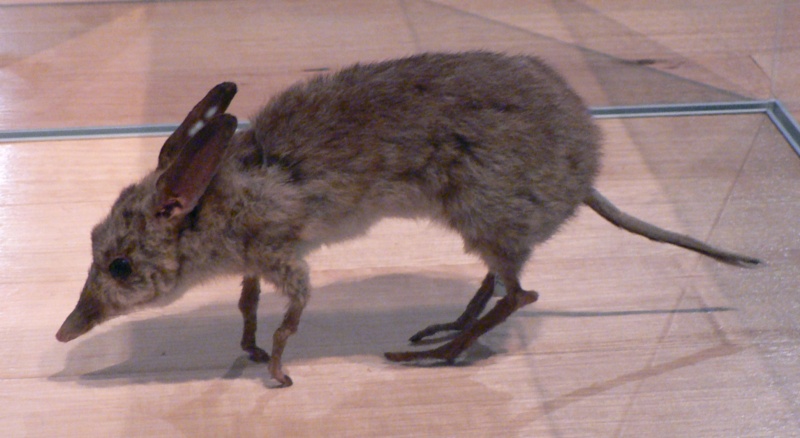This one is doubly depressing to me, because as all Funny Pets diehards know, Crash Bandicoot is one of our biggest stars.
The pig-footed bandicoot, was a small marsupial of the arid plains of Australia. The range of the species was later reduced to an inland desert region, where it was last recorded in the 1950s, and is now presumed to be extinct.

The pig-footed bandicoot had a body size of 23–26 cm and a 10–15 cm long tail. In form, it was almost bilby-like on first sight, having long, slender limbs, large, pointed ears, and a long tail. On closer examination, however, it became apparent that the pig-footed bandicoot was very unusual for a marsupial. The forefeet had two functional toes with hoof-like nails, rather similar to a pig or deer. The hind feet had an enlarged fourth toe with a heavy claw shaped like a tiny horse's hoof, with the other toes being vestigial:only the fused second and third toes being useful, and that not for locomotion but for grooming.
Its fur was coarse and straight, but not spiny. In color it varied from grizzled grey through fawn to orange-brown, the belly and underparts were white with the fur on the ears being of chestnut color.

This species had five pairs of upper and three pairs of lower incision teeth. The females of the species had eight nipples and the opening of the pouch was faced backwards, not forwards as is the case with kangaroos.
Few scientists had the opportunity to observe a live pig-footed bandicoot. The Aboriginal people of central Australia, who knew it well and reported that if disturbed, it was capable of running with considerable speed by breaking into a smooth, galloping sprint.
It was a solitary, nocturnal animal that would sleep in its shelter during the day and emerge in the evening to feed, using its keen sense of smell to find food.
It appears that the pig-footed bandicoot was the most herbivorous of bandicoots; although captive specimens were fond of meat and Aborigines reported that it ate grasshoppers, ants and termites, the bulk of its diet was almost certainly leaves, roots and grasses. In captivity it was observed that they drank "a good deal of water".
According to Indigenous Australians, this species was rare even before the arrival of Europeans on the continent and was in a serious decline even as it first came to scientific notice in the middle years of the 19th century. By 1945 the species vanished from South Australia and was reported to be limited to "a slight foothold in central Australia". Nevertheless, Aboriginal people report that it survived as late as the 1950s in the Gibson Desert and the Great Sandy Desert of Western Australia.
The cause of the extinction remains uncertain: neither of the two most destructive introduced exterminator species, the fox and the rabbit, had yet arrived in south-west Western Australia when the pig-footed bandicoot disappeared from that area. Feral cats were already common, which may offer an explanation; it is perhaps more likely that the decline was caused by a double habitat change. Firstly, the end of many thousands of years of Aboriginal burning which, being confined to a patchwork of small areas at any one time, had ensured both fresh new growth in the recently burnt areas and adjacent older growth for shelter and as a base for recolonisation. However, Australia's Aboriginal population had declined by around 90% during the 19th century, largely because of the introduction of European diseases, and the remaining Aborigines were often no longer permitted to carry on their traditional land-management and hunting practices. Secondly, following on the heels of the near-extermination of the Aborigines, came the introduction of vast numbers of sheep and cattle, leading to significant changes in soil structure, plant growth, and food availability.

PIG-FOOTED BANDICOOT, GONE BUT NEVER FORGOTTEN

